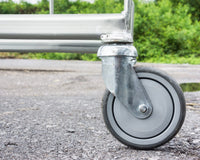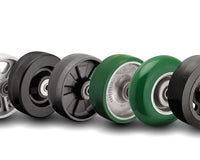In the world of industrial equipment, it is often desired to lower the center of gravity to prevent tipping and conceal the casters for a more aesthetically appealing design—but to do this, a low-profile caster that could carry heavy loads would be required.
Casters, the humble wheels mounted to the underside of equipment, machinery, or furniture, allow them to be easily moved and maneuvered. Traditionally, casters were bulky and conspicuous, limiting their applications in industries where space constraints and aesthetics are paramount. However, the advent of low-profile high-load capacity casters has revolutionized the landscape, offering a sleek, space-saving solution without compromising on mobility or durability.
So, what exactly are low-profile casters, and why are they beneficial?
Understanding Low-Profile Casters
Low-profile casters are designed to provide compact mobility while minimizing the overall height of the equipment they are attached to. Unlike their traditional counterparts, which often protrude prominently, low-profile casters are engineered to be sleek and inconspicuous, making them ideal for applications where space is at a premium or a minimalist design aesthetic is desired.
These casters feature a reduced overall height, compressing the usual swivel section with minimal clearance to the wheel. Durability is achieved through innovative design, a typically larger swivel section and wider wheel footprint, and the use of durable materials such as high-grade stamped or welded metal, glass-filled nylons, and various other wheel materials. Despite their diminutive stature, low-profile casters boast impressive load-bearing capacities and smooth mobility, sometimes featuring precision ball bearings in the wheels, making them suitable for a wide range of applications such as server racks, vending machines, industrial dollies, machinery, racks, tables, and fixtures.
Versatility in OEM Production
The versatility of low-profile casters makes them invaluable across various industries and applications:
- Industrial Equipment: Low-profile casters are a favorite for many pieces of industrial equipment, including material handling dollies, machinery, and other heavy pieces of equipment that do not often move.
- Retail Fixtures: Retail displays, shelves, and racks require mobility for easy reconfiguration and cleaning. Low-profile casters enable smooth movement without detracting from the aesthetic appeal of the fixtures, making them an ideal choice for enhancing functionality.
- Electronic Enclosures: As electronic devices become increasingly compact, the demand for low-profile casters in electronic enclosures continues to rise. These casters facilitate the movement and stable storage of servers, networking equipment, and other enclosures within data centers and office environments, optimizing accessibility and maintenance procedures.
- Furniture: From workstations, tables, and cabinets, manufacturers rely on low-profile casters to enhance mobility and usability. These casters can typically be more concealed in designs, offering smooth gliding motion without compromising on style or stability.
Advantages Over Traditional Casters
The adoption of low-profile casters offers several distinct advantages:
- Space Optimization: Low-profile casters help maximize usable space by reducing the overall height of equipment and furniture, enabling more efficient storage and layout configurations while keeping your center of gravity lower.
- Enhanced Aesthetics: The sleek, unobtrusive design of low-profile casters complements contemporary design trends, ensuring that products maintain a streamlined and visually appealing appearance. Available in both bright zinc and black finishes, you will be able to blend to your base or completely cover them from vision with skirting or paneling.
- Maneuverability: Despite their compact size, low-profile casters still deliver exceptional mobility and maneuverability, allowing for smooth transportation and positioning of equipment in diverse environments. Using dual wheel versions will further enhance the swivel-ability of your equipment as the wheels can rotate independently of each other for tighter turning.
- Durability and Reliability: Engineered with high-quality materials and precision engineering, low-profile casters offer long-lasting performance and durability, minimizing maintenance requirements and downtime.
Conclusion
In the fast-paced world of industrial production, every component plays a pivotal role in shaping the performance, functionality, and aesthetics of the final product. Low-profile casters may often go unnoticed, but their impact is undeniable. From industrial facilities to retail environments and beyond, these unassuming wheels are driving innovation, efficiency, and versatility, proving that when it comes to mobility, sometimes the best solutions come in small packages.



